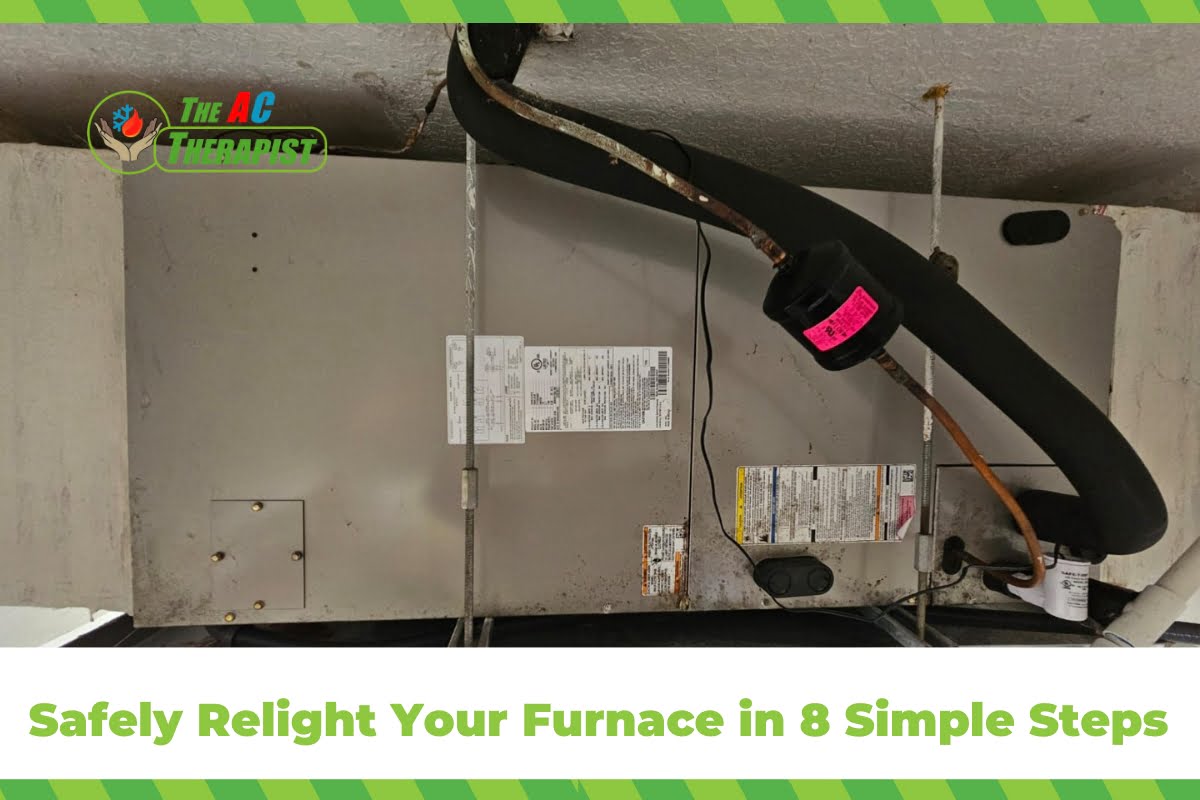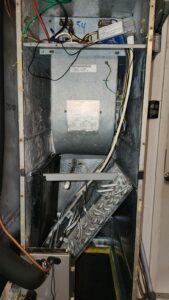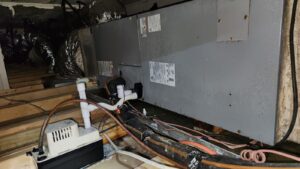Safely Relight Your Furnace in 8 Simple Steps
As the seasons change, ensuring your home remains a haven of comfort is crucial. One key aspect of this comfort is maintaining a warm and cozy environment, especially during the colder months. This often means making sure your furnace is in working order. Whether it’s been shut off for the summer or you’ve encountered a minor hiccup requiring a restart, relighting your furnace is a task that, while seemingly simple, demands care and understanding to ensure safety and efficiency. In this comprehensive guide, we’ll walk you through the steps to safely relight your furnace, outline common mistakes to avoid, and provide essential safety tips to keep your home warm and risk-free.
Understanding Your Furnace
Before embarking on the journey of relighting your furnace, it’s crucial to grasp the basics of how your furnace operates and the types you might encounter. This knowledge not only aids in the relighting process but also helps in troubleshooting should any issues arise. Most residential furnaces are either gas or electric, with gas furnaces being more common in areas where natural gas is readily available and cost-effective.
Types of Furnaces
- Gas Furnaces: These are the most prevalent types of furnaces in homes that use natural gas or propane as fuel. Gas furnaces heat the home by burning gas in a combustion chamber, and this heat is then transferred to the air circulating through the home’s ductwork.
- Electric Furnaces: Electric furnaces use electric heating elements to heat air, similar to how a toaster works. These are typically found in areas where electricity is less expensive than gas or where gas is not available.
- Oil Furnaces: Less common, oil furnaces operate by burning oil to produce heat. They are primarily found in areas where other fuels are not as accessible.
Components of a Gas Furnace
To safely relight your furnace, focusing on gas furnaces, you’ll need to be familiar with a few key components:
- Thermostat: This device controls the temperature in your home and signals the furnace to turn on or off.
- Gas Valve: Controls the flow of gas to the furnace. It has several positions including “off,” “on,” and “pilot.”
- Pilot Light: A small flame that ignites the gas burner. In modern furnaces, this may be replaced by an electronic ignition system.
- Burners: The part of the furnace where gas is ignited to produce heat.
- Heat Exchanger: Separates the combustion process from your indoor air, ensuring only clean, warm air is circulated through your home.
- Blower Motor: Circulates air through the heat exchanger and into your home’s ductwork.
Pilot Light vs. Electronic Ignition
Older furnaces often use a pilot light that burns continuously, ready to ignite the main burner gas when the thermostat calls for heat. Newer models, however, may use electronic ignition systems, which only ignite the burner gas as needed, improving efficiency and safety. Knowing which system your furnace uses is vital, as the process for relighting or troubleshooting will differ.
Importance of the Model and Manual
Each furnace model has its own specific set of instructions for operation, maintenance, and troubleshooting. Before attempting to relight your furnace, locate your furnace’s manual. It will provide invaluable information tailored to your specific model, including detailed instructions on how to safely relight the pilot light or reset the electronic ignition system.
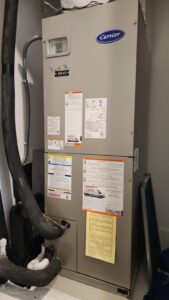
Safety Precautions
When dealing with any furnace, especially when attempting to relight a pilot light or perform maintenance, safety should always be your top priority. Gas furnaces, while efficient and common, involve the handling of natural gas, which can be dangerous if not managed properly. Here are essential safety precautions to ensure the process is safe and to prevent any accidents or damage to your home.
1. Read Your Furnace Manual
Before you do anything, consult your furnace’s user manual. It contains specific safety warnings, maintenance tips, and instructions tailored to your model. This is crucial because every furnace can have slightly different operating procedures and safety features.
2. Turn Off the Gas
Always turn off the gas supply to the furnace before attempting to relight the pilot light. This minimizes the risk of gas buildup or accidental ignition of excess gas. Typically, you should wait at least 5 minutes after turning off the gas to allow any residual gas to dissipate, reducing the risk of a gas explosion.
3. Inspect for Gas Leaks
Before relighting the furnace, check for signs of a gas leak. The smell of sulfur or rotten eggs is a common indicator. If you suspect a gas leak, do not attempt to relight the pilot light or use any electronic devices or open flames in the area. Evacuate immediately and contact your gas company or a professional HVAC technician from a safe distance.
4. Ensure Proper Ventilation
Make sure the area around the furnace is well-ventilated. This helps to prevent any accumulation of gas fumes in the event of a minor leak or when the gas is turned back on. Open doors or windows in the furnace room if possible.
5. Use Appropriate Lighting Tools
If your furnace requires manual lighting, use a long-reach lighter or match to safely ignite the pilot light. This keeps your hands and face away from the flame and reduces the risk of burns.
6. Wear Protective Clothing
Wearing protective gloves and glasses can provide an extra layer of safety, especially when you’re dealing with older furnaces that may have sharp edges or when using matches or lighters.
7. Know When to Call a Professional
If at any point you feel unsure or uncomfortable with the process, or if the furnace does not light after several attempts, it’s best to call a professional. HVAC technicians are trained to handle these situations safely and efficiently. Additionally, if your furnace has a history of operational issues, professional inspection and maintenance may be necessary to ensure it’s safe to use.
8. Regular Maintenance Checks
Preventive maintenance is key to safe furnace operation. Have a certified HVAC professional inspect and service your furnace annually to ensure it’s in good working condition and to prevent potential safety hazards.
9. Monitor Carbon Monoxide Detectors
Ensure your home is equipped with carbon monoxide detectors near sleeping areas and on each level of your home, including the basement. These devices can alert you to the presence of carbon monoxide, a colorless, odorless gas that can be deadly. Check these detectors regularly to ensure they are functioning properly.
Step-by-Step Guide to Relighting Your Furnace
Relighting your furnace’s pilot light can seem daunting, but with careful adherence to safety measures and detailed instructions, it can be a straightforward process. This guide focuses on gas furnaces with a pilot light, as electronic ignition systems typically do not require manual relighting. Before proceeding, ensure you’ve taken all necessary safety precautions.
Step 1: Locate the Pilot Light Assembly and Gas Valve
- Pilot Light Assembly: This is usually found at the bottom of the furnace. You may need to remove a cover or access panel to see it.
- Gas Valve: This valve controls the gas flow to the pilot light and main burner. It typically has three settings: “Off,” “Pilot,” and “On.”
Step 2: Turn Off the Gas Valve
- Turn the gas valve to the “Off” position to stop the flow of gas to the furnace. Wait at least 5 minutes to allow any residual gas to dissipate. This waiting period ensures any gas that has accumulated in the air is cleared, minimizing the risk of ignition.
Step 3: Set the Valve to Pilot
- After ensuring there is no smell of gas, turn the gas valve to the “Pilot” position. This setting allows gas to flow only to the pilot light, not the main burner.
Step 4: Ignite the Pilot Light
- Hold down the reset button or knob (found near the gas valve), which allows gas to flow to the pilot. While holding the button, use a long match or a barbecue lighter to light the pilot light. The reset button or knob may need to be held down for 30-60 seconds after the pilot light ignites to ensure the thermocouple or flame sensor heats up enough to detect the flame and keep the gas flowing.
Step 5: Check the Flame
- Once lit, the pilot flame should be steady and blue, with a slight yellow tip. A strong blue flame indicates a good burn. If the flame is weak, yellow, or goes out frequently, there may be an issue with the pilot light opening or gas supply that needs professional attention.
Step 6: Turn the Gas Valve to On
- After the pilot light is burning steadily, release the reset button and turn the gas valve to the “On” position. This will allow gas to flow to the main burner.
- Listen for the main burner to ignite, indicating the furnace is operational. You should hear a whooshing sound as the burner ignites.
Step 7: Replace the Furnace Cover
- Once the furnace is lit and running properly, replace any covers or access panels you removed during the process.
Step 8: Set Your Thermostat
- Finally, adjust your thermostat to the desired temperature. The furnace should respond to the thermostat setting and begin heating your home.
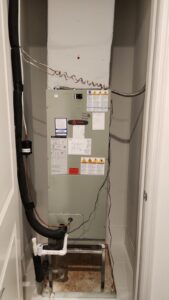
Troubleshooting Common Issues When Relighting Your Furnace
After attempting to relight your furnace, you might encounter some issues that prevent the furnace from operating correctly. Here are some common problems and troubleshooting tips to help you address them safely. If these steps do not resolve the issue, it’s important to consult with a professional HVAC technician to avoid risking your safety or causing damage to your furnace.
The Pilot Light Won’t Stay Lit
- Faulty Thermocouple: The thermocouple is a safety device that detects whether the pilot light is lit. If it’s malfunctioning or misaligned, it may shut off the gas to the pilot light, preventing it from staying lit. Try adjusting the thermocouple so it’s in the flame of the pilot light. If this doesn’t work, the thermocouple may need to be replaced.
- Dirty Pilot Orifice: A clogged pilot orifice can prevent gas from reaching the pilot light. Cleaning the orifice with a needle or a specialized brush can help, but be careful not to damage it.
Furnace Doesn’t Start After Relighting
- Gas Valve Issues: Ensure the gas valve is turned fully to the “On” position. If it’s stuck or faulty, it may not allow gas to flow to the burners.
- Thermostat Settings: Double-check that the thermostat is set to “Heat” and that the temperature setting is above the current room temperature. Sometimes the issue is as simple as the thermostat not signaling the furnace to start.
- Electrical Issues: For furnaces with electronic controls, a tripped circuit breaker or blown fuse can prevent the furnace from starting. Check your home’s electrical panel and reset any tripped breakers or replace blown fuses.
Weak or Yellow Pilot Flame
- Gas Pressure Problems: A weak or yellow flame indicates poor gas pressure or an issue with the gas mixture. This could be due to a variety of factors, including issues with your gas supply. Contacting your gas company or a professional is advised.
- Airflow Obstructions: Ensure there’s no debris or obstruction around the furnace’s air intake or exhaust. Blocked airflow can affect the combustion process, leading to a weak flame.
The furnace Starts but Doesn’t Heat Adequately
- Dirty Air Filter: A clogged air filter can restrict airflow, reducing the furnace’s efficiency and its ability to heat your home. Replacing the air filter might resolve the issue.
- Ductwork Issues: Leaks or blockages in your ductwork can significantly reduce heating efficiency. Inspect accessible ducts for leaks and ensure registers are open and unblocked.
The furnace Turns Off and On Frequently
- Overheating: If the furnace overheats, it may shut off frequently to prevent damage. This can be caused by restricted airflow from a dirty air filter or blocked vents. Check and replace the air filter if necessary.
- Faulty Flame Sensor: A dirty or faulty flame sensor can cause the furnace to shut off as a safety measure if it incorrectly senses no flame. Cleaning or replacing the flame sensor can solve this issue.
Essential Furnace Maintenance Tips from The AC Therapist
At The AC Therapist, your comfort and safety are our top priorities. As your trusted partner in ensuring a warm and cozy home, we want to equip you with the knowledge to keep your furnace running smoothly. Here are our expert maintenance tips, tailored to help you avoid common heating issues and extend the lifespan of your furnace.
1. Regular Air Filter Replacement
A cornerstone of furnace maintenance is the regular replacement of the air filter. Depending on your home’s specific needs, such as pets, allergies, or dust levels, this could mean changing your filter every 1-3 months. A fresh filter not only ensures clean air but also maintains furnace efficiency and prevents unnecessary wear on the system.
2. Maintain a Clean Environment Around Your Furnace
The area surrounding your furnace should be free from clutter, dust, and any stored items. This precaution is not just a safety measure against fire hazards; it also promotes proper airflow, which is crucial for your furnace to operate efficiently.
3. Ensure Vents and Registers are Clear
To facilitate optimal air circulation throughout your home, regularly inspect your vents and registers. They should remain open, unblocked, and clean from dust accumulation. This simple step can significantly impact your heating system’s effectiveness and the overall air quality in your home.
4. Commit to Annual Professional Inspections
Your furnace is a complex system that benefits immensely from the keen eye of a certified HVAC technician. An annual inspection can uncover potential issues before they escalate into costly repairs. From assessing the combustion process to ensuring safe exhaust venting, professional servicing is invaluable for the health of your furnace.
5. Thermostat Checks and Upgrades
Keep an eye on your thermostat’s performance. If it’s time for an upgrade, consider switching to a programmable or smart thermostat. These modern devices enhance your furnace’s efficiency by adjusting your home’s temperature based on your unique schedule and preferences, leading to energy savings and improved comfort.
6. Chimney and Vent System Maintenance
For those with furnaces venting through a chimney or flue, it’s critical to inspect these pathways for any obstructions or blockages, ensuring safe and efficient operation. Regular checks can prevent dangerous exhaust gases from compromising your home’s safety.
7. Stay Alert to Your Furnace’s Operation
Be attentive to how your furnace sounds and operates. Signs like unusual noises, frequent cycling, or a flame color that’s anything other than a clear blue could indicate problems. Recognizing these early warning signs can save you from more significant issues in the future.
8. Ductwork Sealing and Insulation
Inspect your ductwork for leaks or inadequate insulation, especially in areas not typically heated, such as attics or crawl spaces. Properly sealing and insulating your ducts can dramatically improve heating efficiency and reduce your energy bills.
9. Carbon Monoxide Detector Maintenance
Protect your household against the silent threat of carbon monoxide poisoning by installing detectors near sleeping areas and on every level of your home. Regular testing and battery replacement are crucial for ensuring these lifesavers function correctly when you need them most.
10. Furnace Safety Education for Your Family
Ensure everyone in your home understands basic furnace safety principles, such as the importance of maintaining clearance around the heating unit and the steps to take if they detect the smell of gas.
Ensuring Safety While Relighting Your Furnace
In conclusion, learning how to safely relight a furnace is an invaluable skill that can keep your home warm and secure during the colder months. This guide has walked you through the essential steps to relight a furnace safely, emphasizing the importance of understanding your furnace, following safety precautions, and performing routine maintenance. Remember, whether you’re relighting a furnace for the first time after a long summer or addressing a furnace that’s gone out unexpectedly, safety should always come first.
From the initial steps of turning off the gas to the final checks to ensure the pilot light stays lit, each phase in the process of relighting a furnace has been designed with your safety in mind. Regular maintenance and knowing when to call a professional are also key components of furnace safety, ensuring that your attempts to relight a furnace do not lead to bigger issues down the line.
At The AC Therapist, we understand the importance of having a reliable furnace during the colder seasons and the comfort it brings to your home. That’s why we emphasize the need to relight a furnace safely and encourage homeowners to familiarize themselves with their heating system. If you ever feel unsure about how to relight a furnace or encounter issues beyond simple relighting, we are here to help. Our team of professionals is just a call away, ready to ensure that your furnace runs safely and efficiently.
By keeping these guidelines in mind, you can confidently approach the task of relighting a furnace, ensuring your home remains a warm, haven throughout the chilly seasons. Remember, the key to a warm home and peace of mind lies in knowing how to relight a furnace safely and when to seek professional assistance for your furnace needs.

